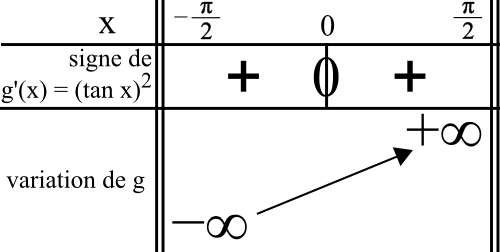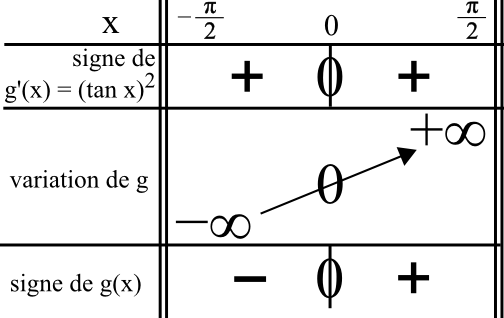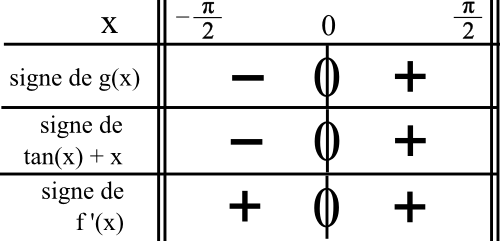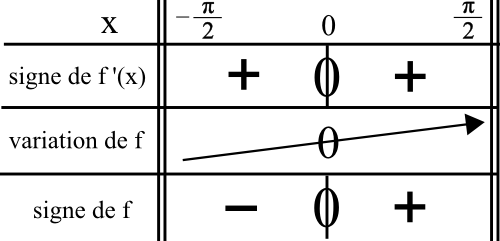Exercice : Clic droit vers l’exercice
Tout le corrigé :
1) Rédaction :
Pour montrer qu’une fonction est impaire, il faut montrer que l’image de -x par la fonction g vaut l’opposé de l’image de x. Soit g(-x) = -g(x).
Donc pour tout x,
g(-x) = tan(-x) – (-x)
= -tan(x) + x (car la fonction tan est impaire : sin/cos donc impaire/paire qui est impaire car -/+ donne -)
= -(tan(x) – x)
= -g(x).
Donc g est impaire.
2) Rédaction :
En –Π/2 supérieur :
lim[x → –Π/2 sup] tan(x) = -∞.
lim[x → –Π/2 sup] x = –Π/2 sup.
Par somme/différence, lim[x → –Π/2 sup] g(x) = -∞.
De la même manière, lim[x → +Π/2 inf] g(x) = +∞ (car tan tend vers +∞).
3) Rédaction :
Pour étudier les variations de g, calculons sa dérivée.
Pour tout x,
g(x) = tan(x) – x
donc pour tout x,
g'(x) = tan'(x) – 1

Donc g'(x) = (tan(x))2 + 1 – 1 = (tan(x))2.
Comme un carré est toujours positif ou nul, (tan(x))2 est toujours positif. Il sera nul seulement en 0 car seul tan(0) = 0.
Le tableau est donc :


4) Rédaction :
g(0) = tan(0) – 0 = 0 – 0 = 0.
Je mets la valeur 0 dans le tableau ci-dessus.


5) Rédaction :
Pour tout x,
f(x) = tan(x) – x – x3/3
pour tout x,
f'(x) = tan'(x) – 1 – 3x23



Donc f'(x) = (tan(x))2 + 1 – 1 – x2
= (tan(x))2 – x2.
6) Rédaction :
f'(x) = (tan(x))2 – x2
= a2 – b2 (troisième identité remarquable)
= (a – b)(a + b)
= [tan(x) – x] × [tan(x) + x]
= g(x) × [tan(x) + x]
x et tan(x) sont négatifs avant 0 et positifs après 0, donc leur somme également.
Le tableau de signe est :


7) Rédaction :
Comme f'(x) est positif sur Df, f est croissante sur Df.
8) Signe de f(x) et inégalité :
Rédaction
On a la variation de f et,
f(0) = tan 0 – 0 – 0 = 0 – 0 – 0 = 0.
Donc le tableau est :


On a donc f(x) ≤ 0 sur ] –Π/2 ; 0 ]
et f(x) ≥ 0 sur [ 0 ; Π/2 [.
Donc tan x – x – x3/3 ≤ 0 sur ] –Π/2 ; 0 ].
Et tan x – x – x3/3 ≥ 0 sur [ 0 ; Π/2 [.
Du coup, tan x ≤ x + x3/3 sur ] –Π/2 ; 0 ].
Et tan x ≥ x + x3/3 sur [ 0 ; Π/2 [.
Donc ce n’est pas vrai pour les x positifs.
Bonne compréhension,
Sylvain Jeuland

